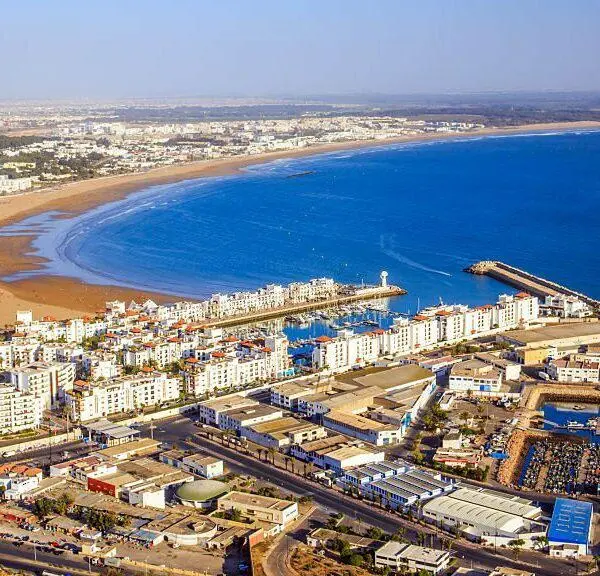
Agadir, a vibrant city on Morocco’s southern Atlantic coast, has a fascinating history marked by resilience and cultural convergence. Originally a small fishing village, Agadir was established by the Berbers, Morocco’s indigenous people, whose presence dates back to antiquity. Throughout the centuries, Agadir’s strategic location attracted various empires and cultures, each leaving an indelible mark on its heritage.
In the 16th century, the Portuguese, driven by their maritime ambitions, briefly occupied Agadir, constructing a fort to bolster their trading activities in the region. However, their control did not last long, as the Saadian dynasty, a powerful Moroccan kingdom, reclaimed the city in 1541. Agadir then began to thrive as a hub for trade, particularly in gold, spices, and slaves, connecting Africa to Europe through an extensive network of routes.
The French protectorate period in the early 20th century introduced another layer to Agadir’s cultural fabric. Under French influence, the city underwent significant modernization, seeing improvements in its infrastructure and the establishment of various civic amenities. This era marked the beginning of Agadir’s transformation into a modern port and subsequently a key tourist destination.
A pivotal event in Agadir’s history is the devastating earthquake of 1960. Striking on February 29, this natural disaster demolished much of the city, resulting in a tremendous loss of life and property. Despite this tragedy, Agadir’s spirit of resilience prevailed. The city was meticulously rebuilt from the ruins, adopting modern urban planning principles that blend contemporary architecture with traditional Moroccan elements. The reconstruction efforts led to a more structured and safer city, setting a foundation for its future growth.
Today, the rich cultural tapestry of Agadir is a testament to the diverse influences that have shaped it over the years. From its humble beginnings as a fishing village to its evolution into a bustling port and tourist magnet, Agadir stands as a symbol of endurance and cultural amalgamation. The remnants of its varied past, from Berber traditions to French colonial architecture, continue to draw visitors seeking an authentic Moroccan experience.
Historical Landmarks in Agadir
Agadir, a city renowned for its stunning coastal views and vibrant culture, also harbors a wealth of historical landmarks which offer glimpses into its storied past. One of the most significant sites is the ancient Kasbah of Agadir Oufella. Perched atop a hill, this fortress, dating back to the 16th century, provides panoramic views of the city and the Atlantic Ocean. Although much of the original structure was devastated by the catastrophic earthquake of 1960, its walls and outlines remain, standing as a poignant reminder of Agadir’s resilience and enduring legacy.
Another cornerstone of Agadir’s historical landscape is the Museum of Amazigh Culture. Devoted to the rich history and culture of the Berber people, or Amazigh, this museum offers a comprehensive array of artifacts, including traditional tools, jewelry, and textiles. Visitors to the Museum of Amazigh Culture can gain deep insights into the traditions, art, and lifestyles of the indigenous inhabitants of the region, celebrating the Berber heritage that has been an integral part of Agadir’s identity.
The Talborjt Mosque is yet another landmark that encapsulates the spirit and resilience of Agadir. Established post-earthquake, the mosque not only serves as a place of worship but also stands as an architectural marvel. Its contemporary design juxtaposed with traditional Islamic elements showcases the city’s ability to blend modernity with heritage. As a symbol of rebirth and continuity, it exemplifies the cultural and historical significance that courses through the veins of Agadir.
These historical landmarks collectively paint a vivid picture of Agadir’s journey through time. They offer visitors not just a sense of place and heritage but also an appreciation for the unique tapestry of history that has shaped this coastal gem. A journey through these sites allows one to unravel the intricate layers of Agadir’s past and its ongoing narrative of resilience and cultural richness.
Natural Wonders and Beautiful Beaches
Agadir, a coastal jewel in Morocco, is renowned for its spellbinding natural landscapes and pristine beaches. The experience begins with Agadir Beach, a sprawling expanse of golden sands that stretches for miles. This beach is acclaimed for its ideal conditions for relaxation, where the gentle lapping of waves complements the warmth of the sun. It is also a paradise for water sports enthusiasts, offering activities such as surfing, jet-skiing, and parasailing, making it a sought-after destination for tourists and locals alike.
Further enhancing Agadir’s allure is the Souss-Massa National Park. This protected area is a biodiversity hotspot, home to a wide array of wildlife including the rare bald ibis. The park’s diverse ecosystems span from coastal dunes to marshlands, providing a habitat for numerous bird species and other fauna. Visitors can immerse themselves in the serenity of this natural sanctuary, where guided tours offer insightful glimpses into the rich biodiversity and conservation efforts.
Another highlight is the picturesque Palm Bay, a scenic enclave that offers a more intimate beach experience. Its calm waters and serene environment make it an excellent spot for family outings and quiet retreats. The bay’s stunning panorama becomes a canvas for nature lovers and photographers who seek to capture its unspoiled beauty.
For those yearning for an oasis-like retreat, Paradise Valley is a true gem. Nestled within the Atlas Mountains, this valley is adorned with lush greenery, palm groves, and natural swimming pools that invite endless relaxation. The enchanting landscapes of Paradise Valley, with its crystal-clear water and panoramic views, create a haven of tranquility far removed from the bustling city life.
In essence, Agadir’s mix of coastal charm and natural splendor provides visitors with myriad experiences. Whether basking on the sunlit beaches, exploring the rich ecosystems of national parks, or revelling in the untouched beauty of hidden valleys, Agadir stands as a testament to the magnificence of nature’s creations.
Must-Visit Attractions and Activities
Agadir offers an array of attractions and activities that cater to different interests, making it a vibrant destination for any traveler. One of the first places to visit is the Souk El Had, the bustling local market renowned for its extensive collection of Moroccan crafts, spices, and textiles. Here, visitors can immerse themselves in the local culture, engage with friendly merchants, and perhaps even negotiate a good bargain on unique souvenirs to take back home.
Another notable location is the Marina of Agadir. This vibrant area is a hub of activity, offering a multitude of dining and shopping options, along with a lively nightlife scene. Visitors can enjoy a leisurely afternoon strolling along the waterfront, taking in the scenic views of the yachts docked at the marina, or savoring local culinary delights at one of the many restaurants. The marina also serves as a starting point for various boat tours that provide different perspectives of Agadir’s stunning coastal line.
For those seeking outdoor adventures, Agadir does not disappoint. The city’s beaches are prime spots for surfing enthusiasts. Beginners and seasoned surfers alike flock to these shores to ride the Atlantic waves. Additionally, the surrounding areas offer excellent hiking and golfing opportunities. Nature lovers can explore the trails in the Atlas Mountains, while golf enthusiasts can enjoy a round on one of the beautifully maintained courses that boast stunning views of the landscape.
No visit to Agadir would be complete without a day trip to one of the nearby attractions. The picturesque village of Taghazout, known for its relaxed atmosphere and beautiful beaches, is a popular choice. Another must-see destination is Crocoparc, a fascinating crocodile park that offers education and entertainment for visitors of all ages. Exploring these nearby gems adds a captivating dimension to any Agadir itinerary.
For an enhanced experience, it’s advisable to time your visits to these attractions to avoid peak hours, wear comfortable walking shoes, and stay hydrated, especially during the warmer months. With its diverse offerings, Agadir promises a memorable journey filled with exploration and discovery.
